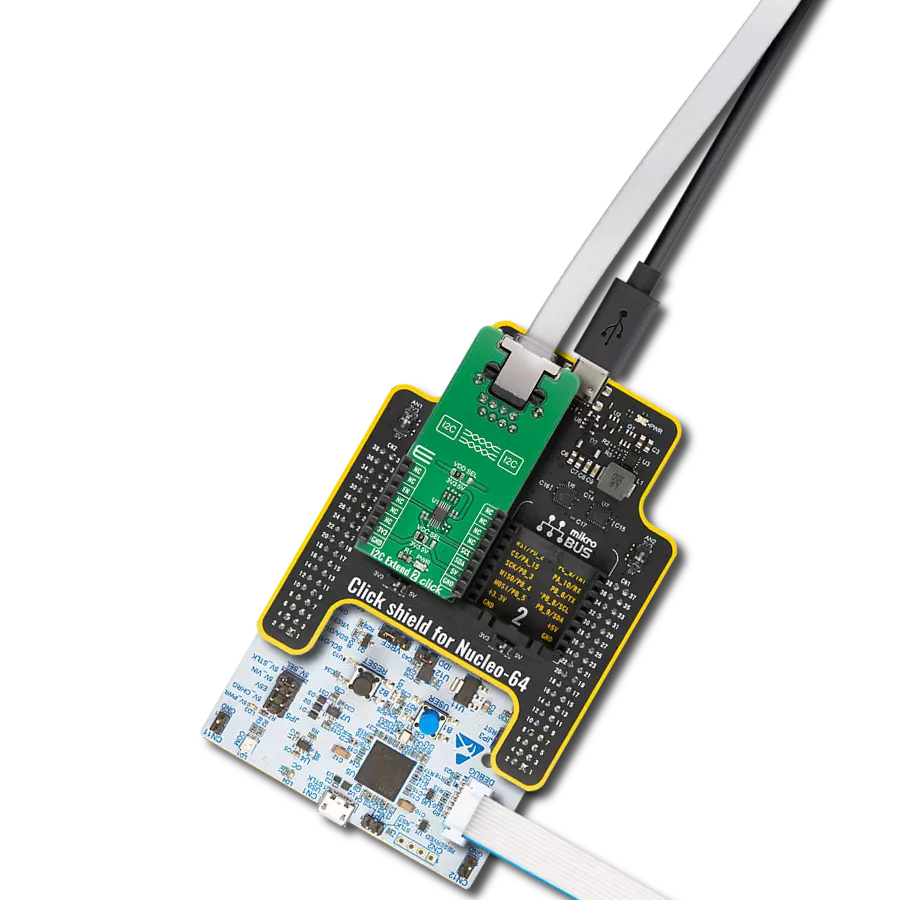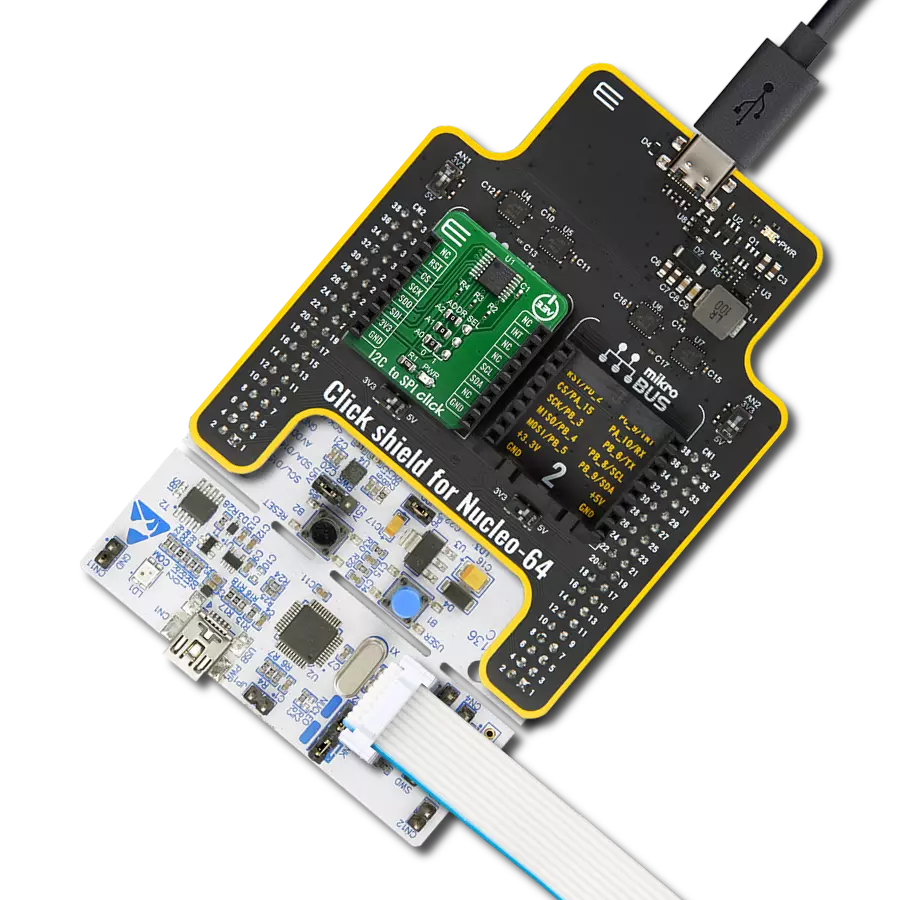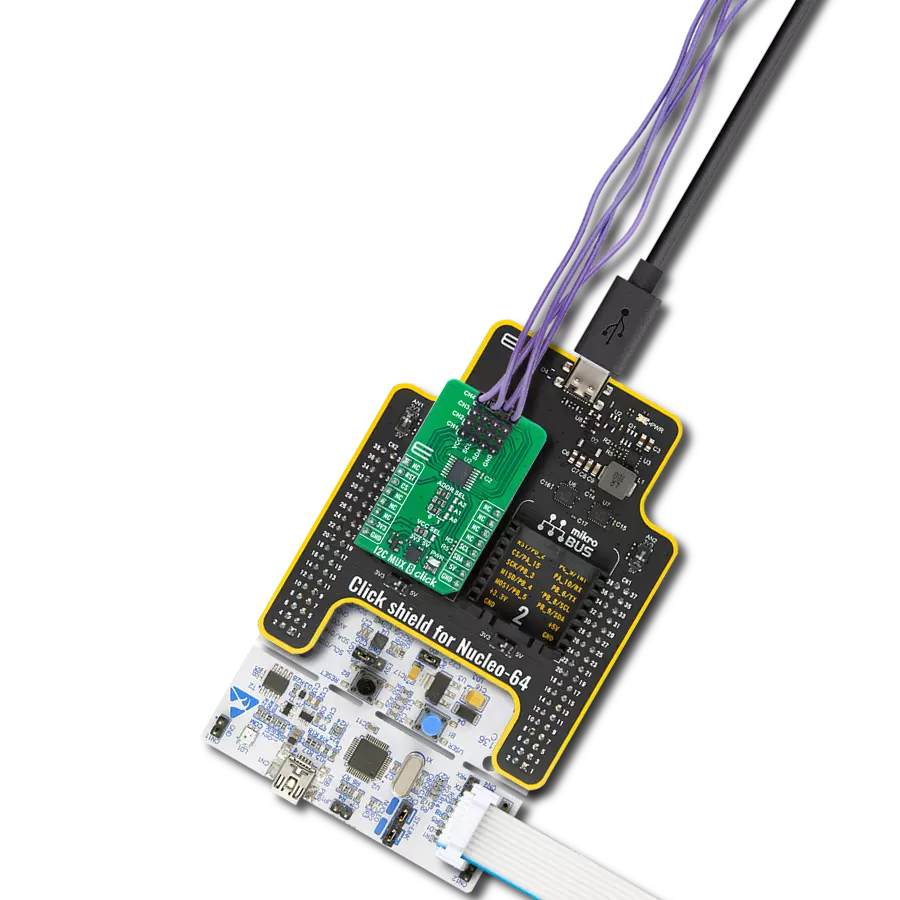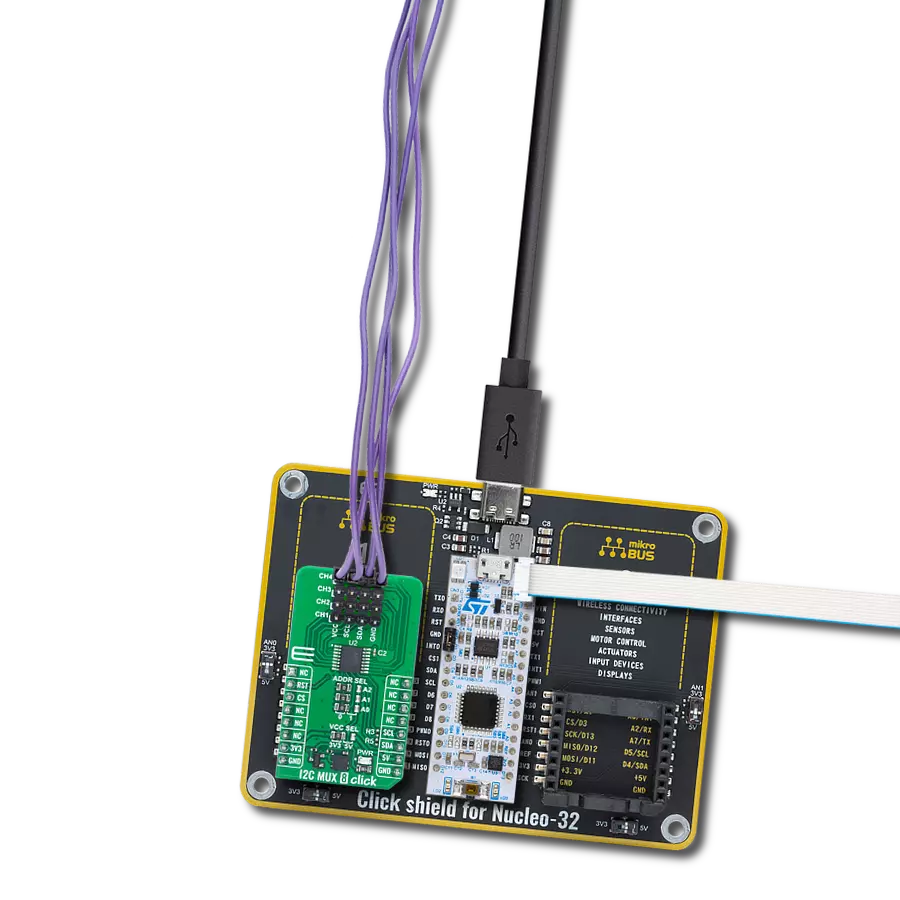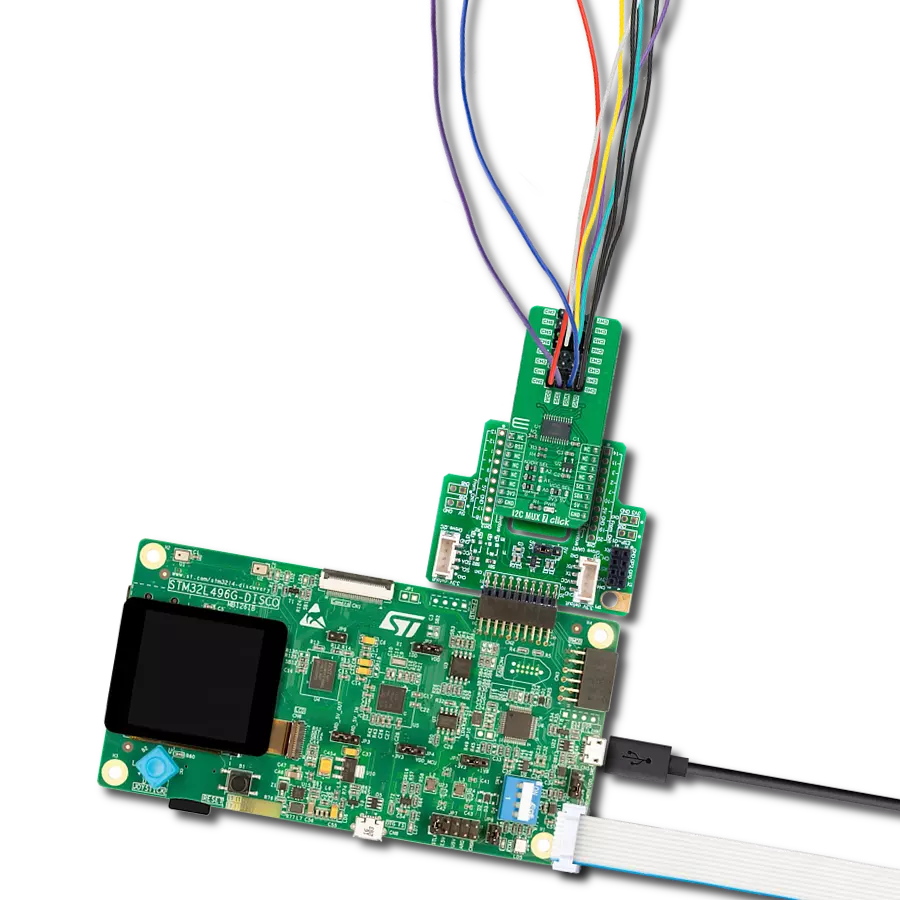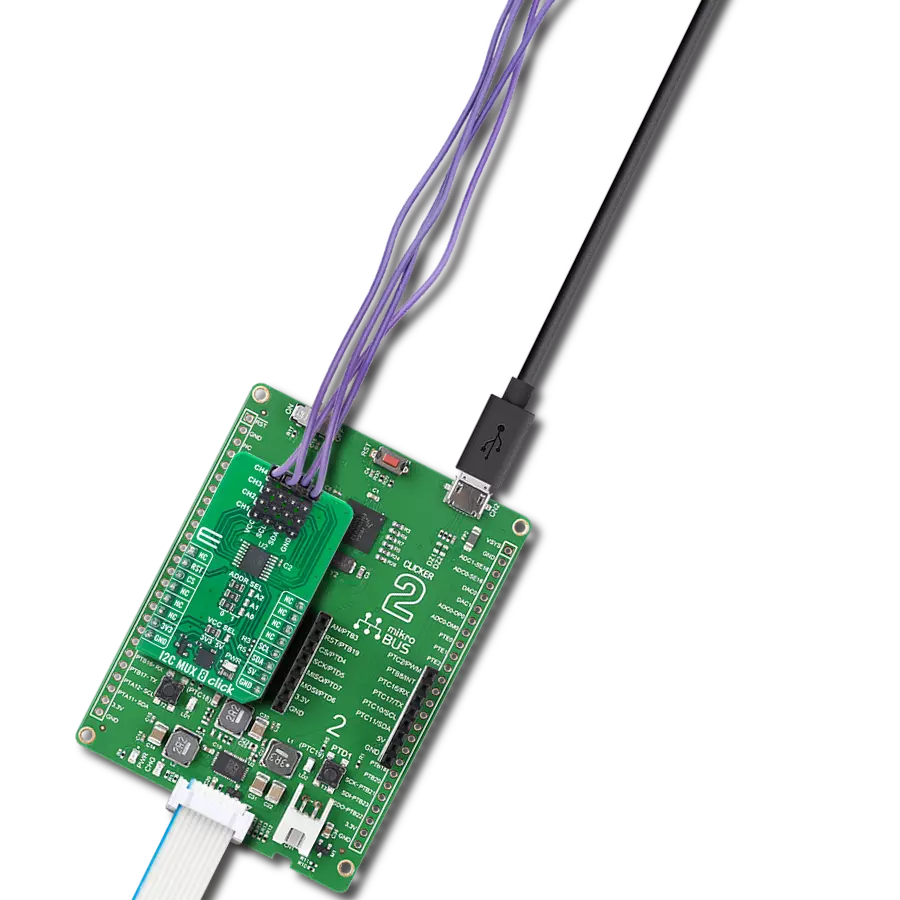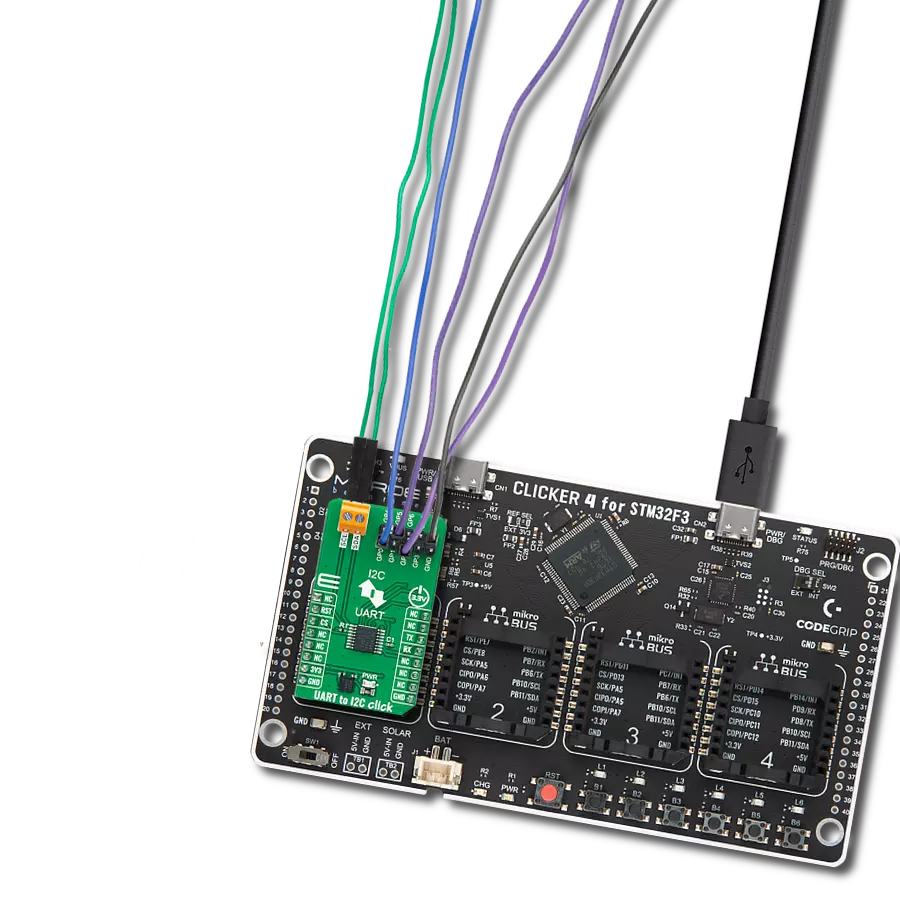Completely isolated I2C interface
A
A
Hardware Overview
How does it work?
I2C Isolator 4 Click is based on the MAX14937, a two-channel, 5kVRMS I2C digital isolator from Analog Devices. The MAX14937 bidirectionally buffers the two I2C signals across the isolation barrier and supports I2C clock-stretching while providing 5kVrms of galvanic isolation. It transfers digital signals between circuits with different power domains at ambient temperatures and offers glitch-free operation, excellent reliability,
and very long operational life. The wide temperature range and high isolation voltage make the device ideal for harsh industrial environments. This Click board™ also possesses two terminals labeled as VIN and SDA/SCL at the bottom of the Click board™, where VIN represents the B-side power supply of the isolator, while the other corresponds to the isolated bidirectional logic-bus terminal.
This Click board™ can operate with either 3.3V or 5V logic voltage levels selected via the VCC SEL jumper. This way, both 3.3V and 5V capable MCUs can use the communication lines properly. However, the Click board™ comes equipped with a library containing easy-to-use functions and an example code that can be used, as a reference, for further development.
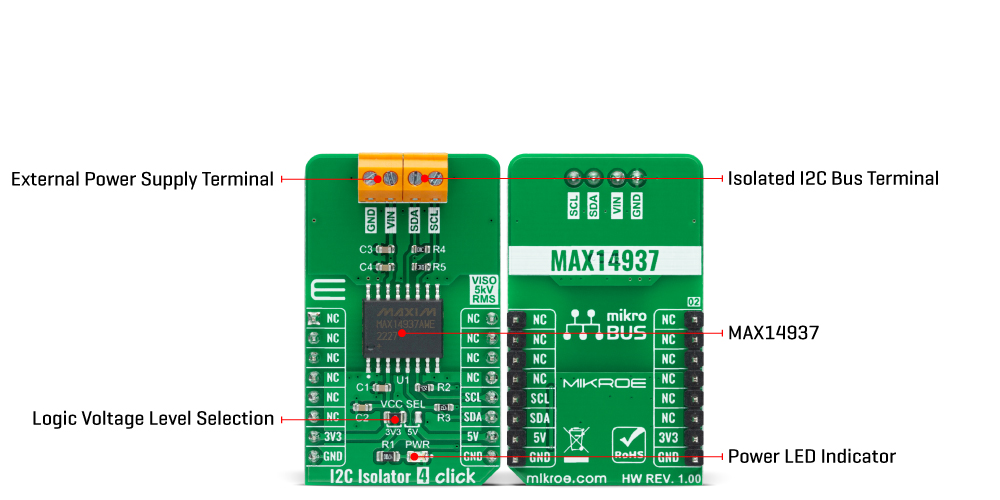
Features overview
Development board
Clicker 4 for STM32F4 is a compact development board designed as a complete solution that you can use to quickly build your own gadgets with unique functionalities. Featuring an STM32F407VGT6 MCU, four mikroBUS™ sockets for Click boards™ connectivity, power management, and more, it represents a perfect solution for the rapid development of many different types of applications. At its core is an STM32F407VGT6 MCU, a powerful microcontroller by STMicroelectronics based on the high-performance
Arm® Cortex®-M4 32-bit processor core operating at up to 168 MHz frequency. It provides sufficient processing power for the most demanding tasks, allowing Clicker 4 to adapt to any specific application requirements. Besides two 1x20 pin headers, four improved mikroBUS™ sockets represent the most distinctive connectivity feature, allowing access to a huge base of Click boards™, growing on a daily basis. Each section of Clicker 4 is clearly marked, offering an intuitive and clean interface. This makes working with the
development board much simpler and, thus, faster. The usability of Clicker 4 doesn’t end with its ability to accelerate the prototyping and application development stages: it is designed as a complete solution that can be implemented directly into any project, with no additional hardware modifications required. Four mounting holes [4.2mm/0.165”] at all four corners allow simple installation by using mounting screws.
Microcontroller Overview
MCU Card / MCU
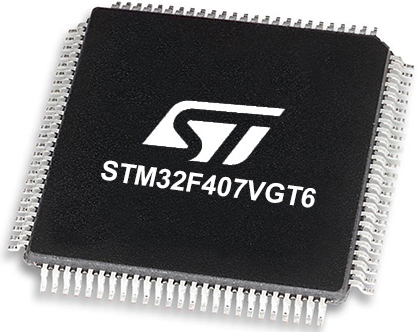
Architecture
ARM Cortex-M4
MCU Memory (KB)
10
Silicon Vendor
STMicroelectronics
Pin count
100
RAM (Bytes)
100
Used MCU Pins
mikroBUS™ mapper
Take a closer look
Click board™ Schematic
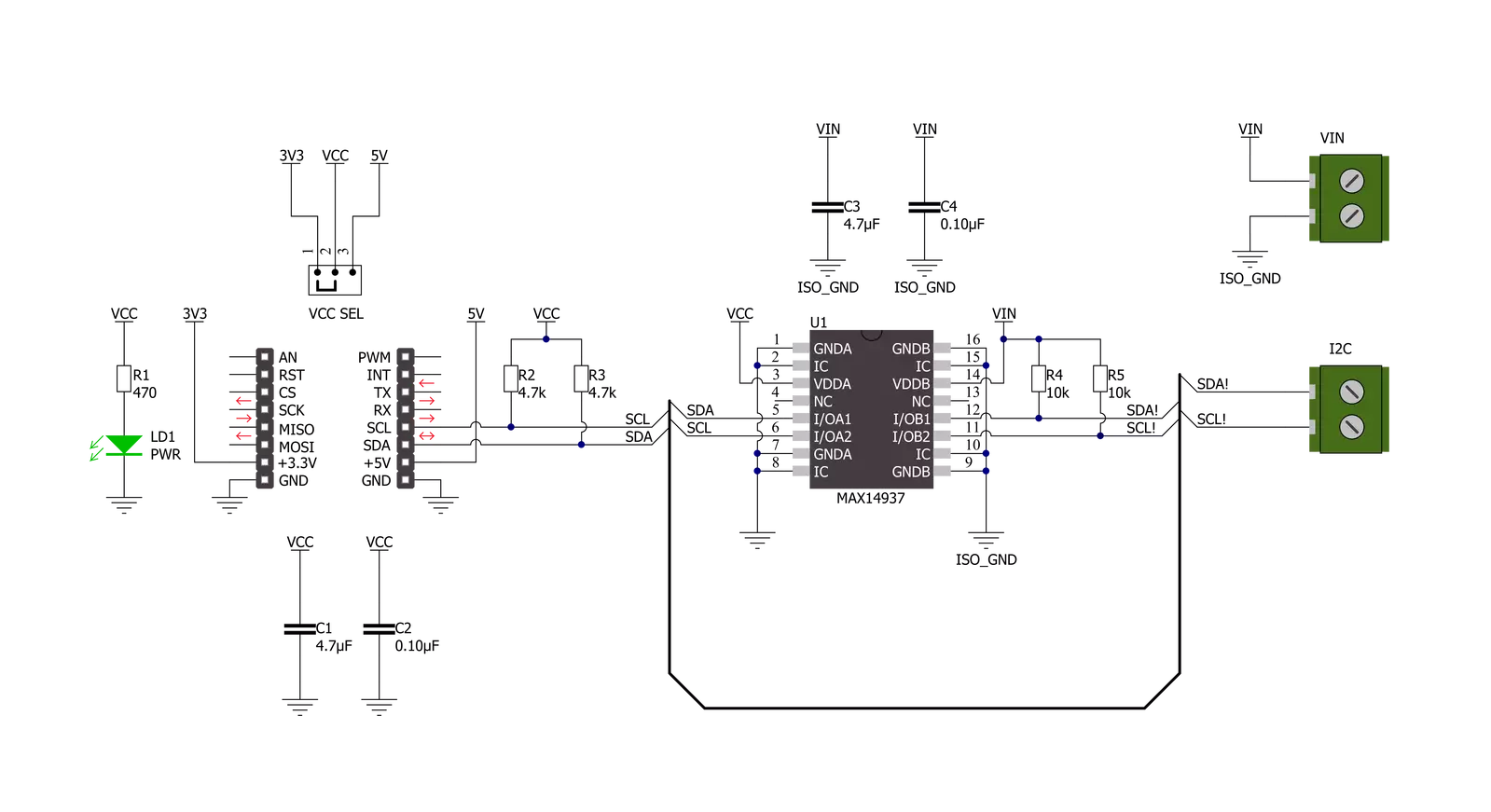
Step by step
Project assembly
Software Support
Library Description
This library contains API for I2C Isolator 4 Click driver.
Key functions:
i2cisolator4_generic_writeI2C Isolator 4 I2C writing function.i2cisolator4_generic_readI2C Isolator 4 I2C reading function.i2cisolator4_set_slave_addressI2C Isolator 4 set I2C Slave address function.
Open Source
Code example
The complete application code and a ready-to-use project are available through the NECTO Studio Package Manager for direct installation in the NECTO Studio. The application code can also be found on the MIKROE GitHub account.
/*!
* @file main.c
* @brief I2cIsolator4 Click example
*
* # Description
* This library contains API for the I2C Isolator 4 Click driver.
* This demo application shows an example of an I2C Isolator 4 Click
* wired to the VAV Press Click for reading
* differential pressure and temperature measurement.
*
* The demo application is composed of two sections :
*
* ## Application Init
* Initialization of I2C module and log UART.
* After driver initialization and default settings,
* the app set VAV Press Click I2C slave address ( 0x5C )
* and enable device.
*
* ## Application Task
* This is an example that shows the use of an I2C Isolator 4 Click board™.
* Logs pressure difference [ Pa ] and temperature [ degree Celsius ] values
* of the VAV Press Click wired to the I2C Isolator 4 Click board™.
* Results are being sent to the Usart Terminal where you can track their changes.
*
* @note
* void get_dif_press_and_temp ( void ) - Get differential pressure and temperature function.
*
* @author Nenad Filipovic
*
*/
#include "board.h"
#include "log.h"
#include "i2cisolator4.h"
#define I2CISOLATOR4_VAV_PRESS_DEV_ADDR 0x5C
#define I2CISOLATOR4_VAV_PRESS_CMD_START_PRESSURE_CONVERSION 0x21
#define I2CISOLATOR4_VAV_PRESS_PRESS_SCALE_FACTOR 1200
#define I2CISOLATOR4_VAV_PRESS_TEMP_SCALE_FACTOR 72
#define I2CISOLATOR4_VAV_PRESS_READOUT_AT_KNOWN_TEMPERATURE 105
#define I2CISOLATOR4_VAV_PRESS_KNOWN_TEMPERATURE_C 23.1
static i2cisolator4_t i2cisolator4;
static log_t logger;
static float diff_press;
static float temperature;
void get_dif_press_and_temp ( void ) {
uint8_t rx_buf[ 4 ];
int16_t readout_data;
i2cisolator4_generic_read( &i2cisolator4, I2CISOLATOR4_VAV_PRESS_CMD_START_PRESSURE_CONVERSION, &rx_buf[ 0 ], 4 );
readout_data = rx_buf[ 1 ];
readout_data <<= 9;
readout_data |= rx_buf[ 0 ];
readout_data >>= 1;
diff_press = ( float ) readout_data;
diff_press /= I2CISOLATOR4_VAV_PRESS_PRESS_SCALE_FACTOR;
readout_data = rx_buf[ 3 ];
readout_data <<= 8;
readout_data |= rx_buf[ 2 ];
temperature = ( float ) readout_data;
temperature -= I2CISOLATOR4_VAV_PRESS_READOUT_AT_KNOWN_TEMPERATURE;
temperature /= I2CISOLATOR4_VAV_PRESS_TEMP_SCALE_FACTOR;
temperature += I2CISOLATOR4_VAV_PRESS_KNOWN_TEMPERATURE_C;
}
void application_init ( void ) {
log_cfg_t log_cfg; /**< Logger config object. */
i2cisolator4_cfg_t i2cisolator4_cfg; /**< Click config object. */
/**
* Logger initialization.
* Default baud rate: 115200
* Default log level: LOG_LEVEL_DEBUG
* @note If USB_UART_RX and USB_UART_TX
* are defined as HAL_PIN_NC, you will
* need to define them manually for log to work.
* See @b LOG_MAP_USB_UART macro definition for detailed explanation.
*/
LOG_MAP_USB_UART( log_cfg );
log_init( &logger, &log_cfg );
log_info( &logger, " Application Init " );
// Click initialization.
i2cisolator4_cfg_setup( &i2cisolator4_cfg );
I2CISOLATOR4_MAP_MIKROBUS( i2cisolator4_cfg, MIKROBUS_1 );
err_t init_flag = i2cisolator4_init( &i2cisolator4, &i2cisolator4_cfg );
if ( init_flag == I2C_MASTER_ERROR ) {
log_error( &logger, " Application Init Error. " );
log_info( &logger, " Please, run program again... " );
for ( ; ; );
}
log_info( &logger, " Application Task " );
Delay_ms ( 100 );
log_printf( &logger, "--------------------------------\r\n" );
log_printf( &logger, " Set I2C Slave Address \r\n" );
i2cisolator4_set_slave_address ( &i2cisolator4, I2CISOLATOR4_VAV_PRESS_DEV_ADDR );
Delay_ms ( 100 );
}
void application_task ( void ) {
get_dif_press_and_temp( );
log_printf( &logger, " Diff. Pressure : %.4f Pa\r\n", diff_press );
log_printf( &logger, " Temperature : %.4f C\r\n", temperature );
log_printf( &logger, "--------------------------------\r\n" );
Delay_ms ( 1000 );
Delay_ms ( 1000 );
}
int main ( void )
{
/* Do not remove this line or clock might not be set correctly. */
#ifdef PREINIT_SUPPORTED
preinit();
#endif
application_init( );
for ( ; ; )
{
application_task( );
}
return 0;
}
// ------------------------------------------------------------------------ END
Additional Support
Resources
Category:I2C
















